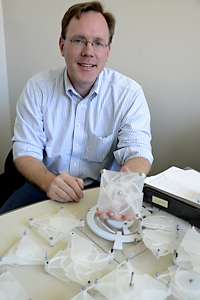Professor designs shape shifters

(Phys.org)—Craig Lusk's job takes on many shapes.
The University of South Florida engineering professor uses a laser to cut sheets of polymer into dynamic, geometric pieces. He uses his research to tie together the shapes in a way that could revolutionize some industries and create new products not yet invented.
Lusk specializes in something called "compliant mechanisms," which refers to the movement, or motion, the precision-cut shapes take on when they interact with each other.
"The idea behind this is I have a surface that is very flexible in the plane. I can compress it, I can expand it, and I can shift it in a motion from side to side in a motion called shearing. So it's very flexible to motions in the plane but it's very rigid if I have something out of plane," said Lusk.
Lusk thinks the strength and flexibility of the surfaces could be incorporated into body armor for police and the military. It could provide a range of motion that Lusk says is similar to the old chain-link armor worn by battling knights, but better because the specially designed springs allow for lightweight, flexible, and extremely durable defense. The shapes could be fashioned into a protective, but collapsible shield as well.
Other applications include robotics and making antennas more flexible and responsive to locating signals. The possibilities for utilizing the shape shifting surfaces are numerous, Lusk said.
Lusk has been working on the original design that he brought with him to USF and has secured a grant from the National Science Foundation to continue his research. Now, he has taken the concept to the next level designing numerous versions, shapes, and sizes of the surfaces.
"This is built based on the idea of lines bending in a plane, like on a flat surface. Now if you make things bend all up out of the plane, you can get things that are a little more complicated," said Lusk as he demonstrated the movements.
The design includes extremely precise geometrical calculations and laser cutting on a computer numeric control machine, in order to align the surfaces perfectly. Dozens of the assembled shapes are scattered around his office, on shelves and filing cabinets.
Provided by University of South Florida



















